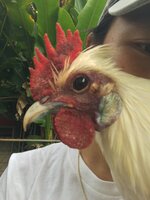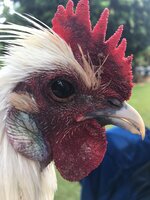chickentenderbunny
Chirping
I have a hen who had a lot of bumps appearing on her face and I later found out it was because of mosquito bites. I was able to treat her with neosporin and she eventually scratched them off and healed.
Now my white rooster is experiencing bumps as well, specifically a large one near his eye and smaller bumps on his crown. At first, I thought he may have the same issue with mosquitos as my hen but the color of it has me worried a bit since they look white. I tried treating it with neosporin as well but it doesn't look like it's helping and the bumps aren't getting smaller at all. Besides the appearance of these bumps, he seems to be doing okay. He's still active and running around, eating and drinking water. Any thoughts as to how I can treat this?


Now my white rooster is experiencing bumps as well, specifically a large one near his eye and smaller bumps on his crown. At first, I thought he may have the same issue with mosquitos as my hen but the color of it has me worried a bit since they look white. I tried treating it with neosporin as well but it doesn't look like it's helping and the bumps aren't getting smaller at all. Besides the appearance of these bumps, he seems to be doing okay. He's still active and running around, eating and drinking water. Any thoughts as to how I can treat this?






 I'll try to find some of this Betadine. Thank you so much for your help and info!
I'll try to find some of this Betadine. Thank you so much for your help and info!